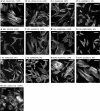p38 (MAPK) stress signalling in replicative senescence in fibroblasts from progeroid and genomic instability syndromes
- PMID: 23112078
- PMCID: PMC3627027
- DOI: 10.1007/s10522-012-9407-2
p38 (MAPK) stress signalling in replicative senescence in fibroblasts from progeroid and genomic instability syndromes
Abstract
Werner Syndrome (WS) is a human segmental progeria resulting from mutations in a DNA helicase. WS fibroblasts have a shortened replicative capacity, an aged appearance, and activated p38 MAPK, features that can be modulated by inhibition of the p38 pathway. Loss of the WRNp RecQ helicase has been shown to result in replicative stress, suggesting that a link between faulty DNA repair and stress-induced premature cellular senescence may lead to premature ageing in WS. Other progeroid syndromes that share overlapping pathophysiological features with WS also show defects in DNA processing, raising the possibility that faulty DNA repair, leading to replicative stress and premature cellular senescence, might be a more widespread feature of premature ageing syndromes. We therefore analysed replicative capacity, cellular morphology and p38 activation, and the effects of p38 inhibition, in fibroblasts from a range of progeroid syndromes. In general, populations of young fibroblasts from non-WS progeroid syndromes do not have a high level of cells with an enlarged morphology and F-actin stress fibres, unlike young WS cells, although this varies between strains. p38 activation and phosphorylated HSP27 levels generally correlate well with cellular morphology, and treatment with the p38 inhibitor SB203580 effects cellular morphology only in strains with enlarged cells and phosphorylated HSP27. For some syndromes fibroblast replicative capacity was within the normal range, whereas for others it was significantly shorter (e.g. HGPS and DKC). However, although in most cases SB203580 extended replicative capacity, with the exception of WS and DKC the magnitude of the effect was not significantly different from normal dermal fibroblasts. This suggests that stress-induced premature cellular senescence via p38 activation is restricted to a small subset of progeroid syndromes.
Figures




Similar articles
-
Assessing the role of stress signalling via p38 MAP kinase in the premature senescence of ataxia telangiectasia and Werner syndrome fibroblasts.Biogerontology. 2009 Jun;10(3):253-66. doi: 10.1007/s10522-008-9179-x. Epub 2008 Oct 1. Biogerontology. 2009. PMID: 18830681
-
Prevention of accelerated cell aging in Werner syndrome using a p38 mitogen-activated protein kinase inhibitor.J Gerontol A Biol Sci Med Sci. 2005 Nov;60(11):1386-93. doi: 10.1093/gerona/60.11.1386. J Gerontol A Biol Sci Med Sci. 2005. PMID: 16339323
-
Small molecule inhibition of p38 MAP kinase extends the replicative life span of human ATR-Seckel syndrome fibroblasts.J Gerontol A Biol Sci Med Sci. 2013 Sep;68(9):1001-9. doi: 10.1093/gerona/gls336. Epub 2013 Feb 11. J Gerontol A Biol Sci Med Sci. 2013. PMID: 23401567 Free PMC article.
-
Evaluating the role of p38 MAP kinase in growth of Werner syndrome fibroblasts.Ann N Y Acad Sci. 2010 Jun;1197:45-8. doi: 10.1111/j.1749-6632.2010.05195.x. Ann N Y Acad Sci. 2010. PMID: 20536832 Review.
-
Prevention of accelerated cell aging in the Werner syndrome.Ann N Y Acad Sci. 2006 May;1067:243-7. doi: 10.1196/annals.1354.031. Ann N Y Acad Sci. 2006. PMID: 16803993 Review.
Cited by
-
An overview of mammalian p38 mitogen-activated protein kinases, central regulators of cell stress and receptor signaling.F1000Res. 2020 Jun 29;9:F1000 Faculty Rev-653. doi: 10.12688/f1000research.22092.1. eCollection 2020. F1000Res. 2020. PMID: 32612808 Free PMC article. Review.
-
New hallmarks of ageing: a 2022 Copenhagen ageing meeting summary.Aging (Albany NY). 2022 Aug 29;14(16):6829-6839. doi: 10.18632/aging.204248. Epub 2022 Aug 29. Aging (Albany NY). 2022. PMID: 36040386 Free PMC article.
-
Werner syndrome: Clinical features, pathogenesis and potential therapeutic interventions.Ageing Res Rev. 2017 Jan;33:105-114. doi: 10.1016/j.arr.2016.03.002. Epub 2016 Mar 15. Ageing Res Rev. 2017. PMID: 26993153 Free PMC article. Review.
-
Partial lipodystrophy with severe insulin resistance and adult progeria Werner syndrome.Orphanet J Rare Dis. 2013 Jul 12;8:106. doi: 10.1186/1750-1172-8-106. Orphanet J Rare Dis. 2013. PMID: 23849162 Free PMC article.
-
A prospect of cell immortalization combined with matrix microenvironmental optimization strategy for tissue engineering and regeneration.Cell Biosci. 2019 Jan 5;9:7. doi: 10.1186/s13578-018-0264-9. eCollection 2019. Cell Biosci. 2019. PMID: 30627420 Free PMC article. Review.
References
Publication types
MeSH terms
Substances
Grants and funding
LinkOut - more resources
Full Text Sources
Molecular Biology Databases
Research Materials
Miscellaneous

